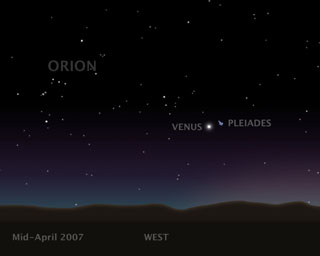
Venus and Pleiades Mingle in the Sky Diagram
The Seven Sisters, also known as the Pleiades star cluster, seem to float
on a bed of feathers in a new infrared image from NASA's Spitzer Space
Telescope. Clouds of dust sweep around the stars, swaddling them in a
cushiony veil.
The Pleiades, located more than 400 light-years away in the Taurus
constellation, are the subject of many legends and writings. Greek
mythology holds that the flock of stars was transformed into celestial
doves by Zeus to save them from a pursuant Orion. The 19th-century poet
Alfred Lord Tennyson described them as "glittering like a swarm of
fireflies tangled in a silver braid."
The star cluster was born when dinosaurs still roamed the Earth, about 100
million years ago. It is significantly younger than our 5-billion-year-old
sun. The brightest members of the cluster, also the highest-mass stars,
are known in Greek mythology as two parents, Atlas and Pleione, and their
seven daughters, Alcyone, Electra, Maia, Merope, Taygeta, Celaeno and
Asterope. There are thousands of additional lower-mass members, including
many stars like our sun. Some scientists believe that our sun grew up in a
crowded region like the Pleiades, before migrating to its present, more
isolated home.
The new infrared image from Spitzer highlights the "tangled silver braid"
mentioned in the poem by Tennyson. This spider-web-like network of
filaments, colored red in this view, is made up of dust associated with
the cloud through which the cluster is traveling. One of the parent stars,
Atlas, can be seen at the bottom, while six of the sisters are visible at
top. Additional stars in the cluster are sprinkled throughout the picture
in blue.
The Spitzer data also reveal never-before-seen brown dwarfs, or "failed
stars," and disks of planetary debris (not pictured). John Stauffer of
NASA's Spitzer Space Telescope mission says Spitzer's infrared vision
allows astronomers to better study the cooler, lower-mass stars in the
region, which are much fainter when viewed in optical light. Stauffer, who
admits to being biased because the Pleiades is his favorite astronomical
object, says the cluster is the perfect laboratory for understanding the
evolution of stars.
This image shows infrared light captured by Spitzer's infrared array
camera. Light with wavelengths of 8 and 5.8 microns is red and orange;
light of 4.5 microns is green; and light of 3.6 microns is blue.
Venus and Pleiades Mingle in the Sky
The sky chart in figure 1 illustrates the Venus-Pleiades encounter that
reached its closest approach on April 11, 2007. The Pleiades are a tight
gem-like cluster of stars that resemble a tiny dipper (but should not be
confused with the Little Dipper constellation). If you look west shortly
after sunset, Venus will be the brightest object in the sky. If the skies
are clear and dark, you'll also see the Pleiades twinkling above Venus. On
April 19, the moon will join the party, sliding between Venus and the
Pleiades. Viewers in the northern and southern hemispheres will be able to
witness the event.